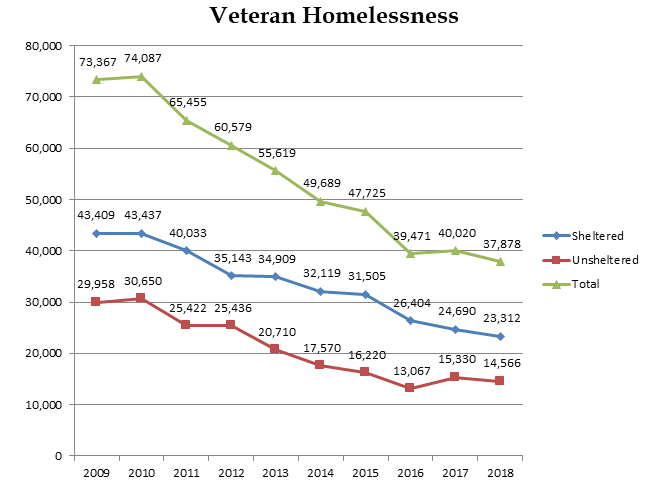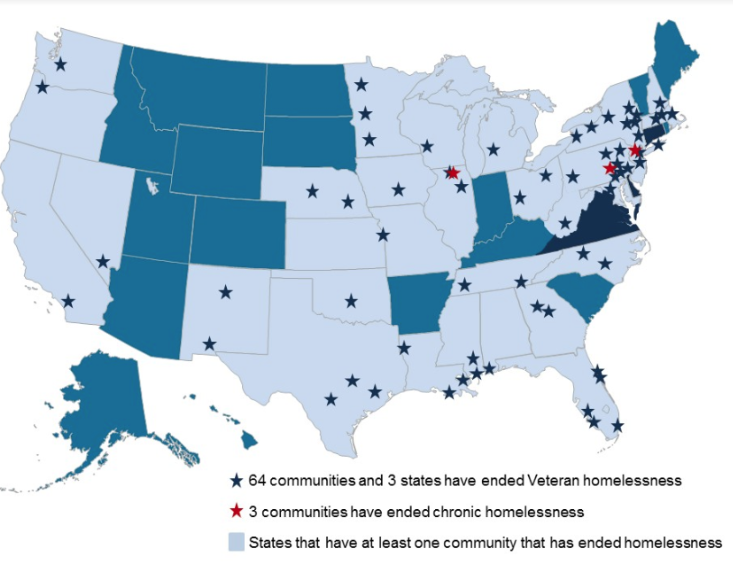After increasing last year, veteran homelessness decreased in 2018 and has plummeted since 2010; in some states, veteran homelessness has even been completely eradicated.
Veteran homelessness decreased by 5.4% since last year, according to the Annual Homeless Assessment Report from the U.S. Department of Housing and Urban Development.
The chart below shows that veteran homelessness plummeted 49% from 74,087 homeless veterans in 2010 to 37,878 homeless veterans in 2018.
Click to Enlarge
(Source: HUD)
“The reduction in homelessness among veterans announced today shows that the strategies we are using to help the most vulnerable veterans become stably housed are working,” said Robert Wilkie, U.S. Department of Veterans Affairs secretary. “This is good news for all veterans.”
However, the chart also shows that last year saw the first increase in veteran homelessness in the past seven years. In fact, some are even criticizing the Trump administration, pointing out that the decrease in veteran homelessness has actually slowed during his presidency.
The decrease in veteran homelessness went from an average of nearly 1,600 per year under former President Barack Obama to about 800 per year under President Donald Trump. Critics say this is not a victory.
Carson is working the numbers here and trying to take credit for other people's work. A few tweets follow. https://t.co/Q71EhzptQC
— Brandon Friedman (@BFriedmanDC) November 1, 2018
Still, the administration said it is proud of the work it has done in reducing homelessness, and says it is committed to ensuring veterans have stable housing.
“We owe it to our veterans to make certain they have a place to call home,” HUD Secretary Ben Carson said. “We’ve made great strides in our efforts to end veteran homelessness, but we still have a lot of work to do to ensure those who wore our nation’s uniform have access to stable housing.”
Each year, thousands of local communities around the country conduct one-night ‘Point-in-Time’ estimates of the number of persons experiencing homelessness—in emergency shelters, transitional housing programs and in unsheltered locations. This year’s estimate finds 37,878 veterans experienced homelessness in January 2018, compared to 40,020 reported in January 2017.
HUD estimates among the total number of reported veterans experiencing homelessness in 2018, 23,312 veterans were found in sheltered settings while volunteers counted 14,566 veterans living in places not meant for human habitation.
HUD attributes much of the reduction to its HUD-VA Supportive Housing Program. It explained this program uses technology to identify the most vulnerable veterans and quickly connect them to the appropriate interventions to become and remain stably housed.
In some states and communities, veteran homelessness has been eradicated completely, according to HUD’s report. The map below shows Virginia, Delaware and Connecticut ended veteran homelessness, along with another 64 U.S. communities. Another three communities have ended chromic veteran homelessness.
Click to Enlarge
(Source: HUD)
“In Home, Together, the new federal strategic plan to prevent and end homelessness, we redouble our commitment to ending homelessness among veterans and among all Americans,” said Matthew Doherty, executive director of the U.S. Interagency Council on Homelessness. “Working together at the federal, state and local level, we can and will continue to make progress until all Americans have a stable home from which they can pursue opportunity.”








